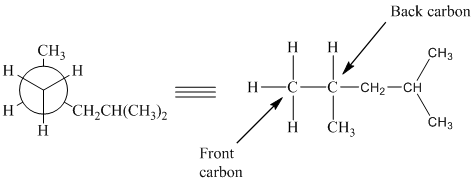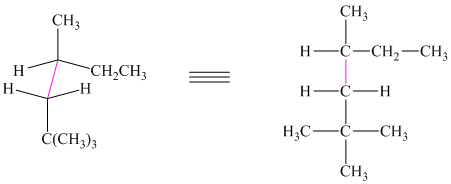
Concept explainers
Give the IUPAC names of each of the following:



(a) (b) (c)
Interpretation:
IUPAC names of the given structures are to be determined.
Concept introduction:
When writing the IUPAC name, the longest continuous carbon chain is first determined. The parent chain is numbered such that the substituents get the lowest numbers.
The location of each substituent group is designated by an appropriate number and name. Prefixes are used if more than one substituents of the same type are present. The substituents are written in alphabetical order.
A cyclic ring hydrocarbon is designated by the prefix cyclo- which appears in front of the base name.
Answer to Problem 20P
Solution:
Explanation of Solution
(a)

In the given Newman projection, the carbon atom at the front is a

In this structure, the longest chain contains five carbon atoms, so the parent alkane is pentane. There are two methyl groups attached to this parent chain. The pentane chain is numbered such that these methyl groups get the lowest numbers.

The two methyl groups are attached to the carbon atoms
(b)
The given sawhorse projection is converted to a skeletal structure as follows:

In this structure, the longest chain contains six carbon atoms, so the parent alkane is hexane. There are three methyl groups attached to the hexane chain. The chain is numbered such that the carbon atoms attached to these three methyl groups get the lowest numbers.

Two methyl groups are attached to
(c)
In the given structure, there are nine carbon atoms in the ring. So the name of parent alkane is cyclononane. The ring is numbered such that the two substituents get the lowest numbers.

There is an ethyl group and an isopropyl group attached to the cyclononane ring. These two groups are trans to each other. Hence the ring is numbered such that the ethyl group gets the lower number since it comes first alphabetically. The IUPAC name of the compound is
Want to see more full solutions like this?
Chapter 3 Solutions
CAREY: ORGANIC CHEMISTRY
- > H₂C=C-CH2-CH3 B. H₂O Pt C. + H2 + H₂O H D. 16. Give the IUPAC name for each of the following: B. Cl Cl c. Cl Cl 17. Draw the line-angle formula for each of the following compounds: 1. phenol 2. 1,3-dichlorobenzene 3. 4-ethyltoluene < Previous Submit Assignment Next ▸arrow_forwardno Ai walkthroughsarrow_forwardThe answer is shown. What is the reaction mechanism to arrive at the answer?arrow_forward
- no Ai walkthroughsarrow_forwardConsider the following nucleophilic substitution reaction. The compound listed above the arrow is the solvent for the reaction. If nothing is listed over the arrow, then the nucleophile is also the solvent for the reaction. Part 1 of 2 Br CH,CN + I¯ What is the correct mechanism for the reaction? Select the single best answer. @SN2 ○ SN 1 Part: 1/2 Part 2 of 2 Draw the products for the reaction. Include both the major organic product and the inorganic product. If more than one stereoisomer is possible, draw only one stereoisomer. Include stereochemistry where relevant. Click and drag to start drawing a structure. X હૈarrow_forward20.33 Think-Pair-Share (a) Rank the following dienes and dienophiles in order of increasing reactivity in the Diels-Alder reaction. (i) CO₂Et (ii) COEt || CO₂Et MeO MeO (b) Draw the product that results from the most reactive diene and most reactive dienophile shown in part (a). (c) Draw a depiction of the orbital overlap involved in the pericyclic reaction that oc- curs between the diene and dienophile in part (b). (d) Is the major product formed in part (b) the endo or exo configuration? Explain your reasoning.arrow_forward
- 20.40 The following compound undergoes an intramolecular Diels-Alder reaction to give a tricyclic product. Propose a structural formula for the product. CN heat An intramolecular Diels-Alder adductarrow_forwardWhat is the reaction mechanism for this? Can this even be done without a base?arrow_forwardWhat is the reaction mechanism for this?arrow_forward
- What is the reaction mechanism for this?arrow_forwardWhat is the reaction mechanism for this?arrow_forwardCurved arrows are used to illustrate the flow of electrons. Using the provided starting and product structures, draw the curved electron-pushing arrows for the following reaction or mechanistic step(s). Be sure to account for all bond-breaking and bond-making steps. + Drawing Arrows CH3ONA, CH3OH heat : Br:O Na → H H Br Na + H H H H H :0: .H + Undo Reset Done Q CH3 Drag To Pan +arrow_forward

 Chemistry for Today: General, Organic, and Bioche...ChemistryISBN:9781305960060Author:Spencer L. Seager, Michael R. Slabaugh, Maren S. HansenPublisher:Cengage Learning
Chemistry for Today: General, Organic, and Bioche...ChemistryISBN:9781305960060Author:Spencer L. Seager, Michael R. Slabaugh, Maren S. HansenPublisher:Cengage Learning

